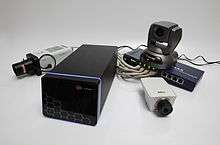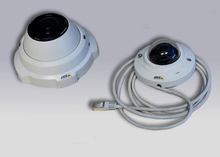IP camera
 A selection of IP cameras | |
| Date invented | 1996 |
|---|---|
| Invented by | Axis Communications |
| First product | Axis Neteye 200 |
| Introduced | 1996 |
| Type | Centralized or Decentralized |
| Slots | SD Card (optional) |
| Connection | Ethernet, Wi-Fi |
| Ports | Ethernet, Audio, I/O block |
| Language | ONVIF and PSIA |
An Internet Protocol camera, or IP camera, is a type of digital video camera commonly employed for surveillance, and which, unlike analog closed-circuit television (CCTV) cameras, can send and receive data via a computer network and the Internet. Although most cameras that do this are webcams, the term IP camera or netcam is usually applied only to those used for surveillance that can be directly accessed over a network connection.
Some IP cameras require support of a central network video recorder (NVR) to handle the recording, video and alarm management. Others are able to operate in a decentralized manner with no NVR needed, as the camera is able to record directly to any local or remote storage media. The first centralized IP camera was Axis Neteye 200, released in 1996 by Axis Communications.[1][2]
History
The first centralized IP camera, the Axis Neteye 200, was released in 1996 by Axis Communications and was developed by the team of Martin Gren and Carl-Axel Alm.[3] Although promoted on its ability to be directly accessible from anywhere with an internet connection,[4] the camera was not capable of streaming real-time motion video, instead being limited to showing a snapshot image each time the camera was accessed. At the time of launch, it was considered to be incapable of operating as a motion camera due to what was conceived as "enormous" bandwidth requirements, thus was aimed primarily at the tourism industry.[5] The Axis Neteye 200 was not intended to replace traditional analogue CCTV systems, given that its capability was limited to just one frame per second in CIF, or one every 17 seconds in 4CIF resolution, with a maximum resolution quality of 0.1MP (352x288).[6] Axis used a custom proprietary web server named OSYS, yet by the summer of 1998, had started working on a software port toward Linux to operate its cameras.[7] Axis also released documentation for its low-level application programming interface (API) called "VAPIX", which builds on the open standards of HTTP and real time streaming protocol (RTSP). This open architecture was intended to encourage third-party software manufacturers to develop compatible management and recording software.

The first decentralized IP camera was released in 1999 by Mobotix. The camera's Linux system contained video, alarm, and recording management functions, thus the camera system did not require licensed video management software to manage the recording event, or video management.[8]
The first IP camera with onboard video content analytics (VCA) was released in 2005 by Intellio. This camera was able to detect a number of different events, such as if an object was stolen, a human crossed a line, a human entered a predefined zone, or if a car moved in the wrong direction.[8]
Video standards
Previous generations of analog CCTV cameras use established broadcast television formats (e.g. Common Intermediate Format (CIF), NTSC, PAL, and SECAM). IP cameras may differ from one another in features and functions, video encoding schemes, available network protocols, and the API to be used by video management software.[9]
IP cameras are available at resolutions from 0.3 (VGA resolution) to 29 megapixels.[10] As in the 21st century, there has been a shift in the consumer TV business towards high-definition (HD) resolutions (e.g. 1080P (Full-HD), 4K resolution (Ultra-HD) and 16:9 widescreen format).
In order to address issues of standardization of IP video surveillance, two industry groups were formed in 2008: the Open Network Video Interface Forum (ONVIF) and the Physical Security Interoperability Alliance (PSIA). While the PSIA was founded by 20 member companies including Honeywell, GE Security and Cisco, and ONVIF was founded by Axis Communications, Bosch and Sony, each group now has numerous members. Cameras and recording hardware operating under the same standard will be able to work with each other, as each device will be communicating in the same language.[9]
Surveillance cameras
Surveillance cameras can use 4G and WiFi to send pictures, videos or make calls.
Dashcams usually employ 4G and front 360° cameras.
Considerations

Potential benefits
IP cameras differ from previous generation analog cameras which transmitted video signals as a voltage, whereas IP camera images are sent using the transmission and security features of the TCP/IP protocol. Some advantages to this approach include:
- Two-way audio via a single network cable allows users to listen to and speak to the subject of the video (e.g. a clerk assisting a customer through step-by-step instructions).
- The use of a Wi-Fi or wireless network.[11]
- Distributed artificial intelligence (DAI) as video analytics can be placed in the camera itself allowing the camera to analyze images.[12]
- Secure data transmission through encryption and authentication methods such as WPA or WPA2, TKIP or AES.
- Remote accessibility allowing live video to be viewed from any device with sufficient access privileges.[13]
- Power over Ethernet (PoE) to supply power through the ethernet cable and operate without a dedicated power supply.
- Image Resolution in IP Cameras has a variety range of its mega pixels rate, 4 times the resolution of an analog camera. [14]
Potential concerns
- Privacy and portrait rights infringement.[15]
- Average higher purchase cost per camera.[16]
- Security could be compromised if credentials are insecure, given that the camera can be accessed independently of a video recorder.
- Public internet connection video can be complicated to set up and may require either a Static IP Address or a Dynamic DNS, although some IP cameras include a built-in dynamic DNS[17] or using the peer-to-peer (P2P) network.
- Data storage can be a concern with IP Cameras, meaning there will be a need of large hard drives to store all the data.[18]
Hacking
As with a CCTV/DVR system, if the video is transmitted over the public internet rather than a private network or intranet, the system potentially becomes open to a wider audience including hackers. Criminals can hack into a CCTV system to disable or manipulate them or observe security measures and personnel, thereby facilitating criminal acts and rendering the surveillance counterproductive. This can be counteracted by ensuring the network and device is secured and staying informed on new security methods. In 2012 users of 4chan hacked into thousands of streaming personal IP cameras by exploiting a vulnerability in some models of Trendnet home security cameras.[19] In 2014 it was reported that a site indexed 73,011 locations worldwide with security cameras that were unprotected by using default usernames and passwords.[20]
See also
- Closed-circuit television camera (CCTV)
- Dashcam
- Trail Camera - outdoor digital camera that operates on batteries and saves motion detected images to an SD card
References
- ↑ "Interview with Martin Gren, inventor of the network camera", SDM Magazine., October 18, 2011, retrieved November 24, 2015
- ↑ John Adams (December 8, 2015), "Martin Gren: IP CCTV's Founding Father", Security Electronics and Networks
- ↑ "Axis Communications - History". Axis Communications. Retrieved 11 July 2017.
- ↑ "IP security camera and network video surveillance visionary". Security News Desk. 29 September 2016. Retrieved 14 July 2017.
- ↑ "Fast and Faster". PC Magazine. 3 December 1996. p. 9. Retrieved 14 July 2017.
- ↑ "Axis NetEye 200 Datasheet" (PDF). Axis Communications. Retrieved 18 November 2017.
- ↑ "Making MPEG Movies with Axis Network Cameras". Linux Journal. 1 March 2001. Retrieved 14 July 2017.
- 1 2 "An Incredibly Unboring History of IP Cameras". Protect America. 12 September 2016. Retrieved 11 July 2017.
- 1 2 "ONVIF: a guide to the open security platform". IFSEC Global. 2016. Retrieved 18 November 2017.
- ↑ "Avigilon Launches Powerful 29 MP HD Surveillance Camera". Avigilon Corporate.
- ↑ Cornett, Ben. "Intro to Surveillance Camera Technologies". EZWatch.com. Retrieved 22 August 2014.
- ↑ Alexandr Lytkin. IP Video Surveillance. An Essential Guide, 2012, ISBN 978-5-600-00033-9.
- ↑ "Home Security". Wireless IP Cameras. Retrieved 10 January 2015.
- ↑ "Top 4 Benefits of Moving from analog to IP video surveliance". frontier-security.com. Retrieved 2 October 2018.
- ↑ https://www.reuters.com/article/us-china-livestreaming/china-surveillance-streaming-platform-shut-down-amid-privacy-concerns-idUSKBN1EE1OU
- ↑ "The Best Home Security Cameras of 2016". PCMAG.
- ↑ David Braue (21 June 2012). "DIY: home surveillance with IP network cameras". CNET. CBS Interactive.
- ↑ "The Pros and Cons of IP Cameras". acctelecom.com. Retrieved 2 October 2018.
- ↑ Notopoulos, Katie (3 February 2012). "Somebody's watching: how a simple exploit lets strangers tap into private security cameras". The Verge. Retrieved 19 February 2017.
- ↑ Smith, Ms. "Peeping into 73,000 unsecured security cameras via default passwords". Network World. Retrieved 19 February 2017.
External links
| Wikimedia Commons has media related to IP cameras. |